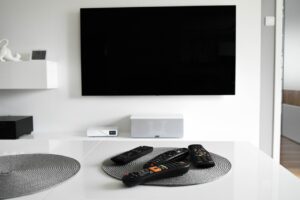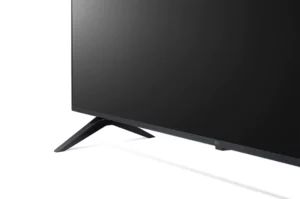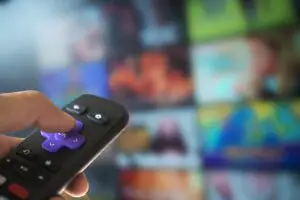One of the most devastating issues that can occur with your TV is a cracked screen.
Whether the TV fell during a move or was accidentally hit by an object, you might be wondering if there’s any way to fix a broken TV screen.
Unfortunately, in most cases, a broken TV screen cannot be repaired. TV manufacturers typically do not offer screen replacements, and there is no secondary market for used screens. The main reason is that the screen is the most expensive component of the TV. The cost of replacing the screen would exceed the price of buying a new TV.
Even local electronics or TV repair shops often refuse to attempt a broken TV screen repair or replacement, as they know it’s not economically viable.
In light of this, it is advisable not to attempt fixing the TV screen yourself, as the chances of success are extremely slim. It’s best to explore other options, such as purchasing a new TV or seeking professional advice on how to proceed.
Why TV Screens Are So Expensive?
To better grasp the reasons behind the high cost of TV screens, let’s delve into the manufacturing process and the complexities involved.

Most TV screens these days are manufactured in the BOE Technology factory in Hefei, China. This facility, where many US TV screens originate, is an enormous undertaking that cost around 7 billion dollars to build. Prominent TV brands like Sony, Samsung, LG, Vizio, and others procure their TV screens from BOE.
Building a TV screen, particularly an LCD screen, is an intricate process. It begins by assembling two thin sheets of glass, forming transistor “cells” using indium tin oxide (ITO), an alloy that remains transparent. This enables electrical signals to reach the middle of the screen. Silicon is then deposited, followed by a meticulous process of constructing millions of precisely shaped transistor parts.
This repetitive patterning creates tiny cells, one for each pixel on the screen. The alignment of each step with the previous one must be extremely precise. The complexity of the manufacturing process requires the involvement of thousands of skilled engineers.
Due to this complexity, only a few companies worldwide are capable of manufacturing TV screens, contributing to their high cost. Moreover, the rigorous testing at the end of the manufacturing process results in a significant number of screens not meeting quality standards, further increasing costs.
Shipping is another factor that impacts the cost. Since the screens are produced in China and shipped across the globe to be sold in the US, transportation expenses are significant, and there is a risk of damage during transit.
Considering these factors, the cost of the screen constitutes a significant portion of a new TV’s price, while the other components, like plastic and circuit boards, are relatively inexpensive. For instance, in a $1,000 TV, the screen’s cost would be around $800, leaving approximately $200 for the plastic and circuit boards.
Add the labor costs for replacing the screen, and it becomes evident why getting the screen replaced is not economically viable. As a result, most TV manufacturers do not sell screens separately.
Does Warranty Cover a Broken/Cracked TV Screen?
If your TV screen has imperfections like discoloration, lines, streaks, spots, or other issues, there’s a good chance that your warranty will cover it, provided it falls within the specified time period. Most TV warranties typically last for the first year and are designed to address manufacturer defects, including these types of problems.

The positive news is that the majority of issues you may encounter with your TV are likely to happen within the first year, during which you are covered by the manufacturer’s warranty.
However, if your TV screen is broken or cracked, it’s unlikely to be covered by the warranty, even if it occurs within the first year of ownership. TV warranties often have specific exclusions that outline what they do not cover, and damages such as breaks or cracks usually fall into these exclusions.
Some common exclusions from TV warranties include:
- cosmetic damage;
- normal wear and tear;
- improper operation;
- improper voltage supply or power surges;
- signal issues;
- damage from shipping;
- acts of God;
- customer misuse, modifications, or adjustments;
- installation, set-up, or repairs attempted by anyone other than by an authorized service center
While this may not be the answer you hoped for, if your TV screen is broken or cracked, you may have no other option than to purchase a new TV. Calling a TV repair person is unlikely to be fruitful, as the majority of them won’t undertake repairs for broken screens due to the impracticality and high cost involved.
What to do of a Broken/Cracked TV?
If you have a broken TV and need to get rid of it, there are a few options you can consider:

Selling Your Broken TV: Selling your broken TV is an option worth considering, as it may still hold value to the right person. Some individuals with expertise in electronics might be interested in buying it to salvage usable parts like speakers, circuit boards, LED strips, and other components.
While you could attempt to disassemble and sell the parts individually, it can be a time-consuming process and may risk damaging the components. Instead, you can try listing the entire broken TV for sale on popular platforms such as Facebook Marketplace, eBay, or Craigslist. Although the TV may not fetch a high price, getting something for it is better than nothing.
If you find it challenging to sell the broken TV, you can try offering it for free on the same marketplaces. Many people are willing to take broken items for free, especially if they see the potential to salvage or repair them. This way, you might find someone interested in taking it off your hands, even if it’s not in perfect condition.
Exploring these selling options gives you a chance to recoup some value from your broken TV and potentially find a new home for it, making it a win-win situation.
Dispose Your Broken TV: If you find that selling your broken TV is not feasible, it’s essential to dispose of it properly to avoid any environmental harm. Here are some simple and responsible ways to get rid of a broken TV:
- Find a local electronics recycler: Many areas have electronics recycling centers where you can drop off your broken TV. Websites like Earth911 can help you locate the nearest recycling facility by typing “TV” and your Zip Code.
- Check with local electronics stores: Some electronics retailers, like Best Buy, offer nationwide recycling programs. They may accept old electronics, including broken TVs, for recycling. Keep in mind that they might charge a small fee for this service.
- Check your town/city’s e-waste collection policies: Many towns and cities have specific guidelines for electronic waste disposal. Check your town or city’s official website for information on e-waste pick-up days or drop-off locations. If in doubt, contact your city’s public works department for guidance.
Remember, it’s crucial not to abandon your broken TV at random donation centers or clothing donation boxes. These are not equipped to handle electronic waste and can cause environmental problems. Taking the time to dispose of your broken TV responsibly will contribute to environmental sustainability and proper waste management.
Ways to Prevent your TV Screen Breaking
Indeed, preventing a broken TV screen is much better than dealing with the hassle of fixing it later on. Here are some effective ways to limit the risk of your TV screen breaking:

- Buy a TV screen protector: Invest in a screen protector designed to cover your TV. These protective screens shield your television from damage and some even offer waterproof capabilities, providing excellent protection against accidental spills or bumps caused by pets and children.
- Mount your TV on the wall: Wall-mounting your TV keeps it elevated and out of reach, reducing the chances of accidental bumps or knocks. Although it may not prevent toys from being thrown at it, it minimizes the risk of someone accidentally colliding with the TV.
- Limit video game usage: If you have young kids or are concerned about potential accidents, consider restricting access to video game consoles connected to the TV. Accidental mishaps, like throwing a Wii controller, can be avoided altogether by not allowing gaming on the TV.
While no preventive measures are foolproof, implementing all three of these steps significantly reduces the likelihood of your TV screen breaking in the future. Taking these precautions can provide peace of mind and help you enjoy your TV worry-free.
Wrapping it up
Fixing a broken TV screen is usually not a viable option due to the high cost and complexity of manufacturing screens. The expense arises from the intricate process involved in creating the screens, often taking place in factories in China and then shipped to the US.
TV repair shops typically refrain from attempting screen repairs because the costs involved in replacing the screen make it impractical. In many cases, the expense of a screen replacement plus the repair costs would be equivalent to buying a completely new TV.
Additionally, warranties generally do not cover damages caused by accidents or mishandling, such as cracked screens. If the damage is due to user actions, it is unlikely that the warranty will cover the repair.
Considering these factors, it may be more practical to sell your broken TV or properly dispose of it and invest in a new television. While it may not be the news you were hoping for, purchasing a new TV is the best course of action to enjoy a fully functional and quality viewing experience.

You May Also Enjoy Reading: Can a Smart TV work without Internet Connection?
